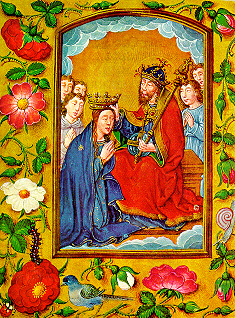Assumption Customs
Assumption Customs
A Variety of Customs Associated with the Assumption
A variety of local, regional and national customs are associated with the Feast of the Assumption on and around August 15.
"During the first millennium of the Christian era, the feast of the Assumption was of enormous importance to most people, since it marked the crowning point of the agricultural year. ... For many centuries before [farming produced two harvests a year], there was only one harvest a year, and this was reaped in July. The feasts of Lammas (the blessing of the first loaves at the beginning of August) and the Assumption (August 15) therefore marked out the period of harvest festivities, and continued to be celebrated as such even after the harvesting had been moved to slightly later in the year.
"In Scotland, the Assumption – St. Mary's Day, or Marymass – was the most important of the Marian feasts, and the ritual Lammas bannock (the new bread) would be dedicated to Mary Mother. In some places people would make pilgrimages on August 15 to holy wells dedicated to Our Lady. Mary long retained her association with the crops, and one fifteenth-century German woodcut shows her wearing a robe which is patterned with ears of [wheat]. So the glorious culmination of the Virgin's life was celebrated at the culmination of the farming year." (Sarah Jane Boss, Marian Study Centre, Ushaw College, Durham)
In Germany, a custom developed which continues today in many parishes. People gather large bouquets of herbs and wildflowers, especially those associated with healing properties. These are brought to the Assumption Vigil or Holy Day Mass, are blessed, and are taken home to be dried and kept for the various purposes of seasoning, healing, and for fragrant decoration of the home.
Prayer Over the Gifts
Liturgy of the Assumption
Lord,
receive this offering of our service. You raised the Virgin Mary to the glory of heaven. By her prayers, help us to seek you and to live in your love. Grant this through Christ our Lord.

Image shown:
Coronation of Mary, Book of Hours, second half of the 15 century, Zwettl, Austria
All About Mary includes a variety of content, much of which reflects the expertise, interpretations and opinions of the individual authors and not necessarily of the Marian Library or the University of Dayton. Please share feedback or suggestions with marianlibrary@udayton.edu.
